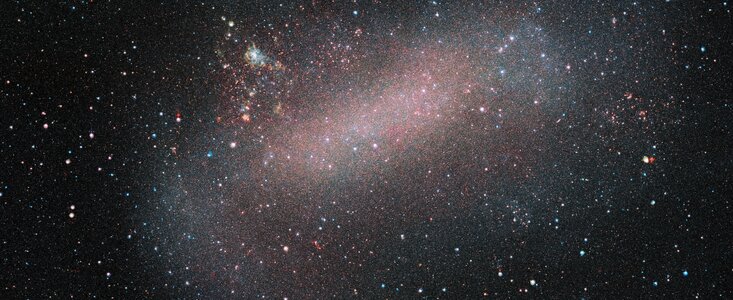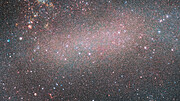Comunicato Stampa
VISTA svela una nuova immagine della Grande Nube di Magellano
13 Settembre 2019
Il telescopio VISTA dell'ESO rivela una straordinaria immagine della Grande Nube di Magellano, una delle galassie più vicine alla nostra. VISTA ha osservato questa galassia e la sua cugina, la Piccola Nube di Magellano, oltre ai loro dintorni, con dettagli senza precedenti. Questa survey consente agli astronomi di osservare un gran numero di stelle, aprendo nuove opportunità di studiare l'evoluzione stellare, la dinamica galattica e le stelle variabili.
La Grande Nube di Magellano, o LMC, è una delle galassie più vicine a noi, a soli 163000 anni luce dalla Terra. Insieme con la cugina, la Piccola Nube di Magellano, sono tra le galassie nane satelliti più vicine alla Via Lattea. L'LMC è anche la sede di vari conglomerati stellari ed è un laboratorio ideale per gli astronomi che studiano i processi che modellano le galassie.
Il telescopio VISTA dell'ESO ha osservato queste due galassie nell'ultimo decennio. L'immagine presentata oggi è il risultato di una delle molte survey che gli astronomi hanno eseguito con questo telescopio. L'obiettivo principale di VMC (survey delle Nubi di Magellano con VISTA) è stato quello di mappare la storia della formazione stellare della Grande e della Piccola Nube di Magellano, nonché la loro struttura tridimensionale.
VISTA è stata fondamentale per la realizzazione di questa immagine perché osserva il cielo a lunghezze d'onda nel vicino infrarosso. Questo permette di vedere attraverso nuvole di polvere che oscurano parti della galassia. Queste nuvole bloccano una grande porzione di luce visibile ma sono trasparenti alle lunghezze d'onda maggiori, quelle per cui VISTA è stata costruita. Di conseguenza, sono chiaramente visibili molte più stelle singole che popolano il centro della galassia. Gli astronomi hanno analizzato in dettaglio circa 10 milioni di stelle nella Grande Nube di Magellano e ne hanno determinato l'età utilizzando modelli stellari all'avanguardia [1]. Hanno scoperto che le stelle più giovani tracciano in questa galassia bracci a spirale multipli.
Per millenni, le Nubi di Magellano hanno affascinato gli abitanti dell'emisfero meridionale, ma erano praticamente sconosciute agli europei fino al momento della scoperta da parte dei primi esploratori. Il nome che usiamo oggi richiama l'esploratore Ferdinando Magellano, che 500 anni fa iniziò la prima circumnavigazione della Terra. I documenti che la spedizione riportò in Europa rivelarono per la prima volta luoghi e cose agli europei. Lo spirito di esplorazione e scoperta è ancora più vivo oggi nel lavoro degli astronomi di tutto il mondo, tra cui l'equipe della Survey VMC, le cui osservazioni hanno portato a questa straordinaria immagine dell'LMC.
Note
[1] I modelli stellari consentono agli astronomi di prevedere la vita e la morte delle stelle, fornendo informazioni su proprietà quali l'età, la massa e la temperatura.
Ulteriori Informazioni
Le stelle rivelate in questa immagine sono discusse nell'articolo “The VMC Survey - XXXIV. Morphology of Stellar Populations in the Magellanic Clouds” che verrà pubblicato sulla rivista Monthly Notices of the Royal Astronomical Society.
L'ESO (European Southern Observatory, o Osservatorio Australe Europeo) è la principale organizzazione intergovernativa di Astronomia in Europa e di gran lunga l'osservatorio astronomico più produttivo al mondo. È sostenuto da 15 paesi: Austria, Belgio, Danimarca, Finlandia, Francia, Germania, Italia, Paesi Bassi, Polonia, Portogallo, Regno Unito, Repubblica Ceca, Spagna, Svezia, e Svizzera, oltre al paese che ospita l'ESO, il Cile e l'Australia come partner strategico. L'ESO svolge un ambizioso programma che si concentra sulla progettazione, costruzione e gestione di potenti strumenti astronomici da terra che consentano agli astronomi di realizzare importanti scoperte scientifiche. L'ESO ha anche un ruolo di punta nel promuovere e organizzare la cooperazione nella ricerca astronomica. L'ESO gestisce tre siti osservativi unici al mondo in Cile: La Silla, Paranal e Chajnantor. Sul Paranal, l'ESO gestisce il Very Large Telescope, osservatorio astronomico d'avanguardia nella banda visibile e due telescopi per survey. VISTA, il più grande telescopio per survey al mondo, lavora nella banda infrarossa mentre il VST (VLT Survey Telescope) è il più grande telescopio progettato appositamente per produrre survey del cielo in luce visibile. L'ESO è il partner principale di APEX e di ALMA, il più grande progetto astronomico esistente, sulla piana di Chajnantor. E sul Cerro Armazones, vicino al Paranal, l'ESO sta costruendo l'Extremely Large Telescope o ELT (significa Telescopio Estremamente Grande), un telescopio da 39 metri che diventerà "il più grande occhio del mondo rivolto al cielo".
La traduzione dall'inglese dei comunicati stampa dell'ESO è un servizio dalla Rete di Divulgazione Scientifica dell'ESO (ESON: ESO Science Outreach Network) composta da ricercatori e divulgatori scientifici da tutti gli Stati Membri dell'ESO e altri paesi. Il nodo italiano della rete ESON è gestito da Anna Wolter.
Links
Contatti
Maria-Rosa Cioni
Leibniz-Institut für Astrophysik Potsdam (AIP)
Potsdam, Germany
Tel.: +49 331 7499 651
E-mail: mcioni@aip.de
Mariya Lyubenova
ESO Head of Media Relations
Garching bei München, Germany
Tel.: +49 89 3200 6188
E-mail: pio@eso.org
Joerg Gasser (press contact Svizzera)
Rete di divulgazione scientifica dell'ESO
E-mail: eson-switzerland@eso.org
Sul Comunicato Stampa
| Comunicato Stampa N": | eso1914it-ch |
| Nome: | Large Magellanic Cloud |
| Tipo: | Local Universe : Galaxy : Type : Irregular |
| Facility: | Visible and Infrared Survey Telescope for Astronomy |
| Instruments: | VIRCAM |
| Science data: | 2019MNRAS.490.1076E |
Our use of Cookies
We use cookies that are essential for accessing our websites and using our services. We also use cookies to analyse, measure and improve our websites’ performance, to enable content sharing via social media and to display media content hosted on third-party platforms.
ESO Cookies Policy
The European Organisation for Astronomical Research in the Southern Hemisphere (ESO) is the pre-eminent intergovernmental science and technology organisation in astronomy. It carries out an ambitious programme focused on the design, construction and operation of powerful ground-based observing facilities for astronomy.
This Cookies Policy is intended to provide clarity by outlining the cookies used on the ESO public websites, their functions, the options you have for controlling them, and the ways you can contact us for additional details.
What are cookies?
Cookies are small pieces of data stored on your device by websites you visit. They serve various purposes, such as remembering login credentials and preferences and enhance your browsing experience.
Categories of cookies we use
Essential cookies (always active): These cookies are strictly necessary for the proper functioning of our website. Without these cookies, the website cannot operate correctly, and certain services, such as logging in or accessing secure areas, may not be available; because they are essential for the website’s operation, they cannot be disabled.
Functional Cookies: These cookies enhance your browsing experience by enabling additional features and personalization, such as remembering your preferences and settings. While not strictly necessary for the website to function, they improve usability and convenience; these cookies are only placed if you provide your consent.
Analytics cookies: These cookies collect information about how visitors interact with our website, such as which pages are visited most often and how users navigate the site. This data helps us improve website performance, optimize content, and enhance the user experience; these cookies are only placed if you provide your consent. We use the following analytics cookies.
Matomo Cookies:
This website uses Matomo (formerly Piwik), an open source software which enables the statistical analysis of website visits. Matomo uses cookies (text files) which are saved on your computer and which allow us to analyze how you use our website. The website user information generated by the cookies will only be saved on the servers of our IT Department. We use this information to analyze www.eso.org visits and to prepare reports on website activities. These data will not be disclosed to third parties.
On behalf of ESO, Matomo will use this information for the purpose of evaluating your use of the website, compiling reports on website activity and providing other services relating to website activity and internet usage.
Matomo cookies settings:
Additional Third-party cookies on ESO websites: some of our pages display content from external providers, e.g. YouTube.
Such third-party services are outside of ESO control and may, at any time, change their terms of service, use of cookies, etc.
YouTube: Some videos on the ESO website are embedded from ESO’s official YouTube channel. We have enabled YouTube’s privacy-enhanced mode, meaning that no cookies are set unless the user actively clicks on the video to play it. Additionally, in this mode, YouTube does not store any personally identifiable cookie data for embedded video playbacks. For more details, please refer to YouTube’s embedding videos information page.
Cookies can also be classified based on the following elements.
Regarding the domain, there are:
- First-party cookies, set by the website you are currently visiting. They are stored by the same domain that you are browsing and are used to enhance your experience on that site;
- Third-party cookies, set by a domain other than the one you are currently visiting.
As for their duration, cookies can be:
- Browser-session cookies, which are deleted when the user closes the browser;
- Stored cookies, which stay on the user's device for a predetermined period of time.
How to manage cookies
Cookie settings: You can modify your cookie choices for the ESO webpages at any time by clicking on the link Cookie settings at the bottom of any page.
In your browser: If you wish to delete cookies or instruct your browser to delete or block cookies by default, please visit the help pages of your browser:
Please be aware that if you delete or decline cookies, certain functionalities of our website may be not be available and your browsing experience may be affected.
You can set most browsers to prevent any cookies being placed on your device, but you may then have to manually adjust some preferences every time you visit a site/page. And some services and functionalities may not work properly at all (e.g. profile logging-in, shop check out).
Updates to the ESO Cookies Policy
The ESO Cookies Policy may be subject to future updates, which will be made available on this page.
Additional information
For any queries related to cookies, please contact: pdprATesoDOTorg.
As ESO public webpages are managed by our Department of Communication, your questions will be dealt with the support of the said Department.








